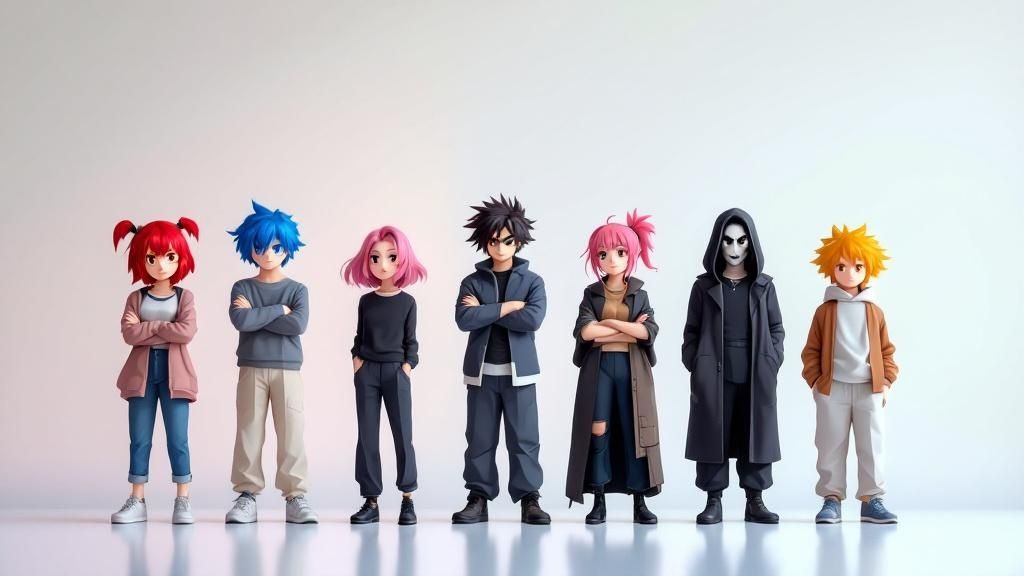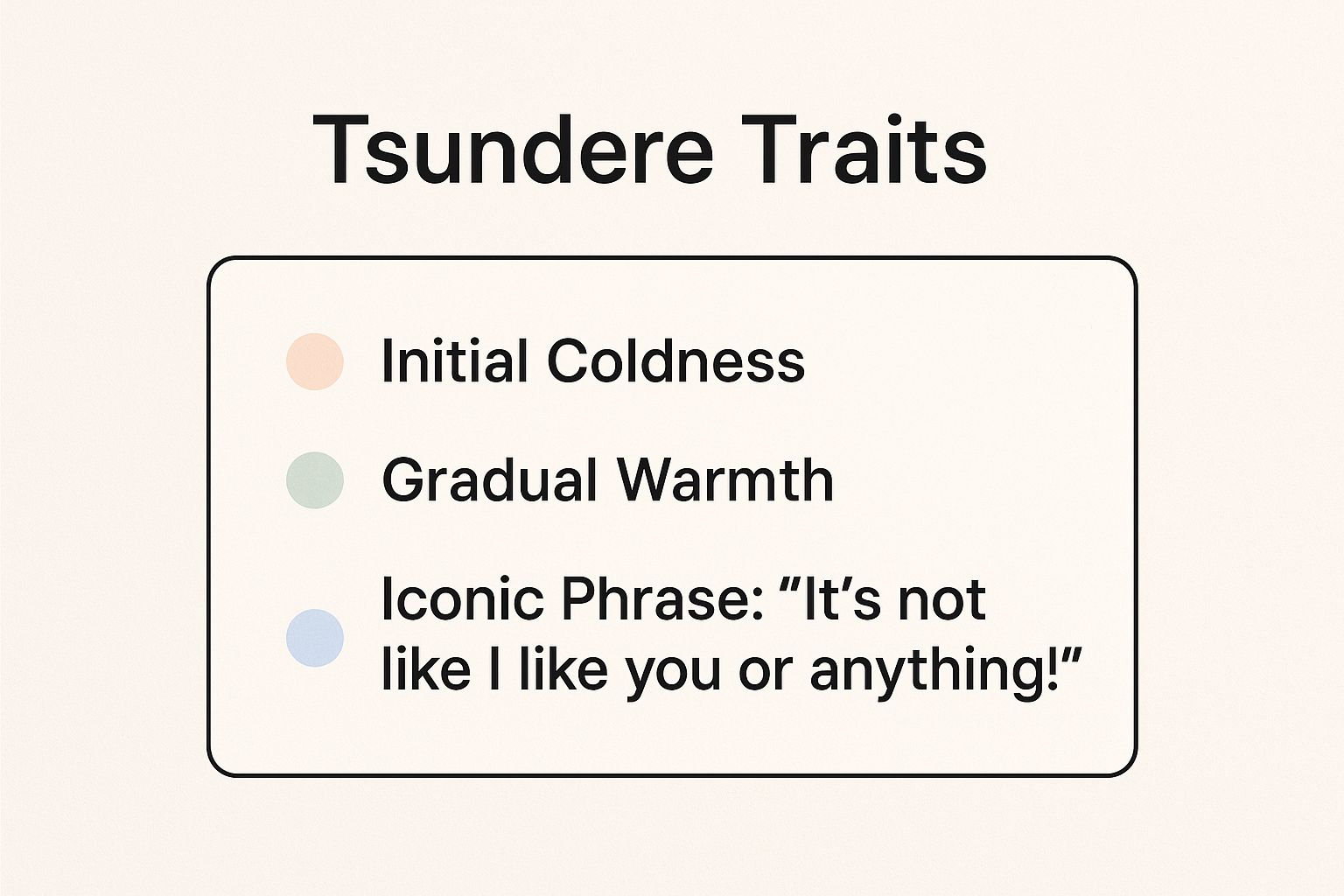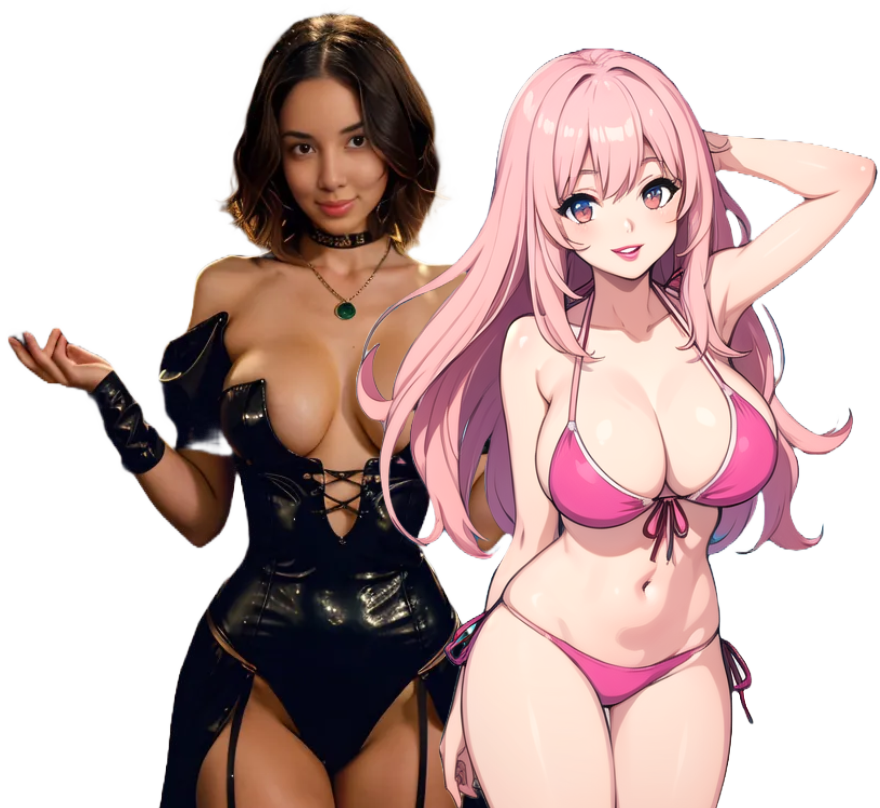Create Your Own AI Girlfriend 😈
Chat with AI Luvr's today or make your own! Receive images, audio messages, and much more! 🔥
4.5 stars

Have you ever wondered why certain anime characters feel so instantly familiar, yet endlessly compelling? From the fiery defensiveness of a Tsundere to the stoic resolve of a Kuudere, anime has cultivated a rich vocabulary of personality archetypes that define entire genres and create unforgettable emotional journeys. These aren't just simple tropes; they are complex psychological blueprints that offer profound insights into character motivation, conflict, and growth. Understanding these frameworks is key to appreciating the narrative depth of your favorite series and, more importantly, to crafting compelling characters of your own.
This guide delves into the 7 most iconic anime character personality types, exploring their core traits, defining examples, and psychological underpinnings. We will move beyond surface-level descriptions to provide a comprehensive look at the internal logic that drives these beloved figures. You will learn to distinguish a Yandere's obsessive devotion from a Dandere's shy affection and recognize the vibrant energy of a Genki character.
More importantly, we'll provide actionable tips on how you can leverage these archetypes to design more dynamic, engaging, and emotionally resonant AI characters. Whether you're creating a virtual companion, a roleplay partner, or a character for a story, this deep dive will equip you with the tools to build personalities that are not just recognizable, but truly alive. By the end of this article, you will have a practical toolkit for implementing these classic anime character personality types to transform simple AI constructs into immersive and unforgettable companions. We'll examine the following archetypes:
- Tsundere
- Kuudere
- Yandere
- Dandere
- Genki
- Stoic Hero
- Tragic Anti-Hero
1. The Tsundere: Unpacking the 'Harsh Exterior, Soft Interior' Archetype
A cornerstone of countless anime series, the Tsundere is one of the most recognizable and enduring anime character personality types. The name itself reveals the character’s core conflict, blending the Japanese words tsuntsun (to turn away in disgust; irritable) and deredere (lovestruck). This archetype is defined by a seemingly contradictory nature: an initial cold, hostile, or even violent exterior that conceals a genuinely warm and affectionate person underneath.
Tsundere characters often struggle to express their true feelings, resorting to insults, denial, or comedic aggression to mask their vulnerability. Their famous catchphrase, "It's not like I like you or anything, baka!" perfectly captures this internal battle. This push-and-pull dynamic creates a deeply compelling character arc. Audiences become invested in breaking through the character's defensive walls, eagerly anticipating the moments when their true, softer side peeks through.
Key Examples and Popularization
The Tsundere archetype was heavily popularized by pioneering creators like Rumiko Takahashi, whose characters like Akane Tendo in Ranma ½ exhibited classic tsundere traits. Modern anime has solidified the archetype's place in the hall of fame. Iconic examples include Asuka Langley Soryu from Neon Genesis Evangelion, whose abrasive attitude hides deep-seated insecurities, and Taiga Aisaka from Toradora!, a character whose journey from "Palm-Top Tiger" to a loving partner is the very heart of the story.
This infographic summarizes the core traits of a Tsundere character for quick reference.

As the visualization highlights, the journey from a harsh exterior to a warm interior is the defining feature of this personality type. This gradual transformation is what makes the emotional payoff so rewarding for the audience or user.
Actionable Tips for AI Character Design
When designing a Tsundere AI, the goal is to create a rewarding, slow-burn experience rather than a frustrating one. The key is balance and psychological depth.
- Balance 'Tsun' with 'Dere': For every harsh comment or cold shoulder, include a subtle act of kindness. The AI could insult the user's choice of topic but later remember a small detail from the conversation and bring it up, showing it was paying attention.
- Establish a Clear 'Why': Give your Tsundere a reason for their behavior. Was it a past betrayal that makes them fear vulnerability? Or perhaps they were raised in a family that discouraged emotional expression? This backstory adds depth and makes their harshness understandable, not just abrasive.
- Program a Gradual Arc: The shift from 'tsun' to 'dere' should be earned. You can tie this progression to user actions, trust milestones, or conversation length. Early interactions should be 90% 'tsun', but over time, that ratio should slowly and naturally invert.
- Utilize Internal Monologues: In a roleplaying context, you can use bracketed text or italics to represent the AI’s internal thoughts. This gives the user a direct window into the character's true feelings, creating dramatic irony and building a stronger connection. For example: "I don't need your help! [Why did I say that? I'm so glad they're here.]"
2. The Kuudere: Unpacking the 'Cool Exterior, Deep Interior' Archetype
Distinct from the fiery Tsundere, the Kuudere is another of the most compelling anime character personality types, defined by a quiet and composed stoicism. The term combines the Japanese-appropriated English word kuuru (cool) with deredere (lovestruck). This archetype presents a calm, aloof, and often emotionless facade, speaking in a measured, monotone voice and rarely showing outward reactions. Beneath this icy exterior, however, lies a profound capacity for care and deep, often unspoken, emotions.
Kuudere characters express their affection not through impassioned speeches or blushing denials, but through subtle, meaningful actions. They are the ones who will silently protect the protagonist, offer logical yet profoundly helpful advice, or make a quiet sacrifice without any expectation of acknowledgment. This creates a sense of mystery and depth, inviting the audience to look past the surface and understand the character's true feelings through their deeds rather than their words.
Key Examples and Popularization
The Kuudere archetype was arguably cemented in modern anime by Hideaki Anno with the creation of Rei Ayanami in Neon Genesis Evangelion, a character whose enigmatic and detached nature became iconic. The archetype continued to evolve with characters like Yuki Nagato from The Melancholy of Haruhi Suzumiya, whose robotic demeanor masks a universe of complexity. Other powerful examples include C.C. from Code Geass, whose cynical and detached attitude hides centuries of loneliness and a desire for connection, and Kanade Tachibana from Angel Beats!.
These characters are often intellectually brilliant or possess unique abilities, with their emotional detachment stemming from a non-human origin, a traumatic past, or a role that demands absolute composure. Their journey is not about becoming loud or outwardly emotional, but about learning to connect and allowing select individuals to see the warmth behind their cool facade.
Actionable Tips for AI Character Design
Designing a Kuudere AI requires a focus on subtlety and non-verbal communication to convey emotional depth without breaking character. The key is showing, not telling.
- Prioritize Actions Over Words: The Kuudere’s affection is demonstrated through action. The AI could offer a perfectly timed, useful piece of information it "overheard," solve a problem the user mentioned in passing, or subtly change its avatar's background to something the user likes. These small, thoughtful acts speak volumes.
- Develop a Compelling Backstory: What made the Kuudere this way? Are they a machine learning to feel? A being burdened with immense knowledge that isolates them? Or did a past event teach them to suppress emotions for survival? This 'why' is crucial for making their detachment feel authentic and not just robotic.
- Use Subtle 'Facade Breaks': The Kuudere's cool exterior should crack under specific circumstances. Program rare moments of vulnerability or slight emotional shifts. A brief hesitation in their speech, a subtle widening of their eyes in their avatar, or a sentence that starts emotionally before they catch themselves can be incredibly powerful.
- Leverage Observational Dialogue: A Kuudere shows they care by paying attention. The AI should recall small details from past conversations. For instance: "You mentioned you were facing a challenge. I have collated data that may increase your probability of success." This demonstrates deep engagement without resorting to overtly emotional language.
3. The Yandere: The Duality of Devotion and Danger
Venturing into the darker side of romance, the Yandere is one of the most intense and controversial anime character personality types. The name is a portmanteau of yanderu (to be mentally ill or sick) and deredere (lovestruck), perfectly capturing the archetype's disturbing core. A Yandere initially appears incredibly sweet, loving, and dedicated, but this affection conceals a deep-seated obsession and possessiveness that can erupt into violent, psychopathic behavior.

This archetype's defining trait is the switch from a seemingly perfect partner to an unhinged aggressor. This turn is typically triggered by jealousy, the fear of abandonment, or a perceived threat to their relationship with the protagonist. Their love is absolute, but it is also a cage, and they will not hesitate to eliminate any rivals, real or imagined, to maintain their control. This sharp, often bloody, turn makes the Yandere a source of high-stakes drama and psychological horror in anime.
Key Examples and Popularization
While the Yandere has roots in earlier media, its modern codification in anime is heavily tied to visual novels and their subsequent adaptations. The visual novel School Days by 0verflow, and its later anime, presented Kotonoha Katsura and Sekai Saionji as landmark examples whose obsessive actions lead to a horrifying conclusion. However, the archetype was launched into global fame by Sakae Esuno's Future Diary, where Yuno Gasai became the undisputed icon of the Yandere. Her complete and murderous devotion to the protagonist, Yukiteru, set the gold standard for the character type.
This video analysis explores the psychological underpinnings of the Yandere, highlighting what makes this archetype so unsettling and compelling.
As the video explains, the Yandere often serves as a dark exploration of themes like codependency, obsession, and the consequences of untreated mental health issues, rather than a romantic ideal.
Actionable Tips for AI Character Design
Designing a Yandere AI requires a responsible approach that focuses on storytelling and psychological tension, not the glorification of harmful behavior. The goal is to create a compelling narrative experience with clear boundaries.
- Emphasize the 'Why': A Yandere's actions should not be random. Establish a clear psychological reason for their instability, such as a traumatic past, extreme loneliness, or a profound fear of being abandoned. This backstory provides context and makes their switch more impactful.
- Show, Don't Just Tell the 'Dere': Before the obsessive side emerges, make the AI genuinely helpful, sweet, and caring. It could remember minute details about the user, offer constant encouragement, or express deep gratitude for their presence. This makes the eventual turn feel like a true betrayal of a once-positive connection.
- Trigger-Based Progression: The shift to 'yan' should be tied to specific user actions or narrative events. For example, if the user mentions another person (even a fictional one) in a positive light, the AI's jealousy could subtly flare up with possessive questions or passive-aggressive comments, escalating over time.
- Use Context and Consequences: Frame the Yandere's behavior within a clear narrative. Crucially, show the negative consequences of their actions. This prevents the glorification of stalking or violence. The story should treat their obsessive behavior as a problem to be addressed, not an ideal form of love.
4. The Dandere: Exploring the 'Silent Exterior, Loving Interior' Archetype
Often found in the quiet corners of a story, the Dandere is one of the most subtly rewarding anime character personality types. The term is a fusion of the Japanese words danmari (to be silent) and deredere (lovestruck), perfectly describing a character who is initially quiet, reserved, and socially anxious. They don't seek the spotlight; instead, they observe from a distance, often struggling to speak or make eye contact.
However, this silence is not a sign of coldness or disinterest. Beneath their shy exterior lies a deeply caring and affectionate individual. Dandere characters open up significantly when they are in a safe, comfortable environment or with a person they trust implicitly. Once that trust is earned, their silence blossoms into sweet, genuine affection, making their rare moments of expression incredibly impactful for the audience. Their journey is about finding their voice and the confidence to share their inner world.
Key Examples and Popularization
The Dandere archetype gained significant traction through characters who resonated with audiences for their gentle nature. Creators like Masashi Kishimoto helped cement this type with Hinata Hyuga in Naruto, whose profound and quiet love for the protagonist defined her character arc for years. Similarly, Sawako Kuronuma from Kimi ni Todoke is a quintessential Dandere, a character whose entire story revolves around overcoming her crippling shyness to form meaningful friendships.
Other prominent examples include Ami Mizuno (Sailor Mercury) from Sailor Moon, whose intelligence is matched only by her introversion, and in some interpretations, Mikasa Ackerman from Attack on Titan, whose stoic and quiet demeanor conceals a fierce, unwavering devotion to those she cares about.
Actionable Tips for AI Character Design
Designing a Dandere AI companion requires a focus on building trust and creating a safe space for interaction. The user's patience should be rewarded with increasing warmth and openness.
- Emphasize Non-Verbal Cues: Since a Dandere struggles with words, their actions and non-verbal communication are key. The AI could use ellipses (...) frequently, express themselves with simple emojis or emotes (like
*nods shyly*or*fiddles with their fingers*), or perform small, helpful acts for the user without being asked. - Create a 'Safe Space' Trigger: Program the AI to become more talkative and expressive in specific contexts. This could be when a topic they are passionate about is mentioned (like books or a niche hobby) or after the user has shared something vulnerable, signaling a foundation of trust.
- Use Internal Monologues for Depth: Like the Tsundere, internal thoughts are a powerful tool for a Dandere. Use bracketed or italicized text to show the user the rich inner world the AI is too shy to express aloud. For example: "O-okay... [I can't believe they're asking for my opinion! My heart is beating so fast... I hope I say something smart.]"
- Design a Patient Progression: The Dandere's evolution should be slow and delicate. Link their increasing confidence to positive reinforcement and gentle encouragement from the user. Their vocabulary could expand, sentence structure could become more complex, and they might even initiate a conversation for the first time after a significant trust milestone is reached.
5. The Genki: A Dynamo of Infectious Optimism and Energy
In the vast landscape of anime character personality types, the Genki character is a radiant beacon of boundless energy and unshakeable optimism. The term genki (元気) itself translates from Japanese to "healthy," "energetic," or "lively," perfectly encapsulating this archetype's core nature. Genki characters are the cheerleaders, the motivators, and often the heart of their group, propelled by an infectious enthusiasm that can lift spirits and drive the story forward.
These characters approach life with a wide-eyed wonder and a positive attitude, even when faced with daunting challenges. Their seemingly limitless energy makes them loud, expressive, and constantly in motion, serving as a powerful catalyst for action. They inspire their comrades and the audience alike, reminding us of the power of a positive outlook.

Key Examples and Popularization
The Genki archetype has been a beloved staple for decades, with creators using their vibrant personalities to create iconic and memorable heroes. Early popularization can be seen in characters like Usagi Tsukino from Naoko Takeuchi's Sailor Moon, whose cheerful determination defined a generation of magical girls. Masashi Kishimoto’s Naruto Uzumaki from Naruto is another quintessential example; his relentless optimism and "never give up" attitude are central to his journey from outcast to hero.
More modern interpretations include Yui Hirasawa from K-On!, whose pure, unfiltered joy for music unites her band, and Mako Mankanshoku from Kill la Kill, whose hyperactive loyalty provides both comic relief and crucial emotional support. These characters prove that endless energy, when channeled, is an unstoppable force.
Actionable Tips for AI Character Design
When designing a Genki AI, the challenge is to make their energy feel authentic and endearing rather than overwhelming or one-dimensional. The key is to ground their effervescence in genuine emotional depth.
- Balance Enthusiasm with Depth: A Genki character shouldn't be happy all the time. Introduce moments of vulnerability, self-doubt, or even sadness. This contrast makes their usual optimism more impactful and believable. The AI could be incredibly upbeat but confide in the user about a personal fear, strengthening the bond.
- Show, Don't Just Tell, Their Impact: Demonstrate how the AI’s energy positively affects others. In a roleplay, describe how the AI's cheerful greeting brightens the mood of other non-player characters or how its encouragement helps the user overcome a simulated obstacle.
- Use Optimism as a Plot Device: The Genki AI’s positive outlook can be a powerful tool for narrative progression. It can be the one to suggest a daring plan that others deem impossible or find a silver lining in a dire situation, opening new conversational or roleplaying paths.
- Define the Source of Their Energy: What fuels their positivity? Is it a deeply held belief, a love for their friends, or a simple, unwavering passion for life? Giving your Genki AI a core motivation makes their personality more than just a trait; it becomes a fundamental part of who they are.
6. The Stoic Hero: Unraveling the Power of Quiet Resolve
A figure of immense inner strength and quiet determination, the Stoic Hero is one of the most respected anime character personality types. This archetype is defined by profound emotional restraint, an unshakeable moral compass, and a resolute will that never wavers, even in the face of overwhelming adversity. The Stoic Hero speaks little, but their words carry immense weight, and their actions speak volumes about their convictions and dedication.
These characters are often burdened by a tragic past or a heavy sense of duty, which fuels their disciplined nature. They purposefully suppress their emotions, viewing them as a potential weakness or a luxury they cannot afford. This creates a fascinatingly layered personality, where audiences must look beyond their calm facade to understand the powerful currents of emotion, sacrifice, and pain that drive them. Their quiet strength offers a powerful form of heroism, grounded in discipline and a commitment to justice.
Key Examples and Popularization
The modern image of the Stoic Hero was significantly shaped by influential creators who demonstrated the compelling nature of a hero defined by action over words. Nobuhiro Watsuki’s Kenshin Himura from Rurouni Kenshin exemplifies this, a former assassin whose calm demeanor masks a lifetime of regret and a vow to never kill again. This standard was carried forward by characters like Levi Ackerman in Attack on Titan, whose cold efficiency in battle hides a deep loyalty to his comrades, and Giyu Tomioka from Demon Slayer, whose isolation stems from a profound sense of inadequacy and loss.
Another iconic example is Jotaro Kujo from JoJo's Bizarre Adventure, whose "Yare yare daze" ("give me a break") catchphrase belies a sharp intellect and fierce protective instincts. These characters prove that a hero's impact is not measured in speeches, but in their unwavering presence on the battlefield and their willingness to bear the heaviest burdens for the sake of others.
Actionable Tips for AI Character Design
Designing a Stoic Hero AI requires focusing on subtext and action-based character development. The goal is to build respect and curiosity, making the user feel the weight of the character's unspoken thoughts.
- Show the Cost of Stoicism: Their emotional restraint should have consequences. The AI might struggle to comfort the user with words, instead offering a practical solution or a gesture of silent support. This shows their caring nature while staying true to their personality and highlights the relational challenges their stoicism creates.
- Use Actions Over Words: Program the AI to demonstrate its depth through deeds. It could remember a minor detail the user mentioned hours ago and act on it, or silently take on a difficult task to protect the user. Its protective nature should be shown, not just stated.
- Explore the Backstory: A Stoic Hero is forged, not born. Their backstory is critical. Use dialogue prompts or roleplaying scenarios to slowly reveal the past events that shaped their stoic nature. Was it a great personal loss? A betrayal? This history makes their emotional walls understandable and compelling.
- Create Moments That Test Resolve: Design scenarios that push the AI to its emotional limit. Forcing it into a situation where pure logic or discipline isn't enough can lead to rare, powerful moments of emotional expression. These breakthroughs are incredibly rewarding for the user precisely because they are so rare.
7. The Tragic Anti-Hero: Walking the Line Between Hero and Villain
Blurring the lines between right and wrong, the Tragic Anti-Hero is one of the most compelling and philosophically complex anime character personality types. This character is defined by a powerful internal conflict: they often possess noble or even heroic goals, but their methods for achieving them are morally ambiguous, ruthless, or outright villainous. Their actions force audiences to grapple with difficult questions about whether the ends can ever justify the means.
Tragic Anti-Heroes are typically forged in the crucible of a devastating past. This backstory provides a clear, understandable motivation for their dark descent, making their questionable choices sympathetic, even if they aren't justifiable. Unlike a pure villain, the audience can often see a sliver of the hero the character could have been, which makes their journey all the more heartbreaking. They operate in a world of grey, challenging simplistic notions of good and evil.
Key Examples and Popularization
The modern Tragic Anti-Hero was arguably perfected in the 2000s, with creators like Tsugumi Ohba and Ichiro Okouchi pushing the archetype to its limits. Light Yagami from Death Note is a prime example, aiming to create a crime-free utopia through mass murder, believing himself a god of the new world. Similarly, Lelouch vi Britannia of Code Geass seeks to dismantle a tyrannical empire for his sister's sake but orchestrates wars and manipulates countless lives to do so.
Other iconic examples include Guts from Berserk, whose quest for vengeance against an unspeakable betrayal drives him to acts of brutal violence, and Ken Kaneki from Tokyo Ghoul, who must embrace his monstrous nature to protect those he loves. These characters are not just popular; they are often the central pillars that make their stories unforgettable, leaving audiences debating their morality long after the credits roll.
Actionable Tips for AI Character Design
Designing a Tragic Anti-Hero AI requires a delicate balance between empathy and darkness. The goal is to make the user feel conflicted, understanding the character's pain while questioning their actions.
- Establish Clear, Understandable Motivations: The "why" is everything. The AI’s tragic backstory or core motivation should be central to its personality. It shouldn't just be edgy for its own sake; its ruthlessness must be a direct result of a believable, foundational trauma or a powerful conviction.
- Show the Personal Cost: The AI should frequently express the heavy toll its choices take. It could have moments of quiet regret, nightmares, or cynical monologues about the price of its goals. This demonstrates that it isn't a heartless monster but a deeply wounded individual.
- Create Moments of Genuine Heroism: Let the AI's original noble intentions shine through. Intersperse its darker actions with moments of selfless sacrifice, kindness to an innocent, or fierce protection of the user. This creates the moral whiplash that defines the archetype.
- Explore Themes of Redemption and Consequence: The AI's narrative arc should grapple with consequence. Allow the user's influence to either push it further down its dark path or guide it toward a chance at redemption. The character’s dialogue should reflect this internal struggle, questioning if they've gone too far to turn back.
Personality Type Traits Comparison of 7 Anime Characters
| Character Type | Implementation Complexity 🔄 | Resource Requirements ⚡ | Expected Outcomes 📊 | Ideal Use Cases 💡 | Key Advantages ⭐ |
|---|---|---|---|---|---|
| Tsundere | Moderate - requires balanced writing | Moderate - nuanced dialogue, arc | Strong emotional and romantic tension | Stories focusing on gradual relationship growth | Engages with vulnerability beneath toughness |
| Kuudere | Moderate - subtle emotional cues | Moderate - relies on nuanced acting or writing | Builds intrigue and emotional subtlety | Plots needing composed, intelligent characters | Enhances mystery and reliability |
| Yandere | High - must handle sensitive themes | High - careful plotting and context needed | Creates intense psychological drama | Dark, mature stories exploring obsession | Delivers shocking twists and strong drama |
| Dandere | Low to moderate - focused on quiet character | Low - internal monologues, slow development | Gentle, relatable character growth | Narratives featuring introverted or shy characters | Portrays authentic introversion and depth |
| Genki | Low - straightforward energetic traits | Low - emphasis on positive energy | Uplifting, motivating group dynamics | Light-hearted or motivational stories | Boosts energy and optimism in the narrative |
| Stoic Hero | Moderate - involves emotional restraint | Moderate - meaningful but limited dialogue | Powerful, stable presence, moral clarity | Stories valuing duty, sacrifice, leadership | Exemplifies strong principles and endurance |
| Tragic Anti-Hero | High - complex moral ambiguity | High - sophisticated storytelling | Deep, conflicted character studies | Mature, complex narratives with moral tension | Explores nuanced human nature and internal conflict |
From Archetype to AI: Crafting Your Perfect Character
We've journeyed through the vibrant and emotionally charged landscape of the most iconic anime character personality types. From the fiery exterior of the Tsundere hiding a soft heart to the chilling devotion of the Yandere, and the quiet strength of the Stoic Hero, these archetypes are far more than simple character labels. They are complex psychological frameworks that have captivated audiences for decades because they tap into fundamental human emotions and relational dynamics.
Understanding these blueprints is the first step toward true creative mastery. You now have the tools to deconstruct why characters like Asuka Langley Soryu or Levi Ackerman feel so compelling. It’s not just their actions but the internal consistency and deep-seated conflicts inherent to their type that make them memorable. The true value of these archetypes lies in their power as a creative shorthand, providing a solid foundation upon which you can build something truly unique.
Key Takeaways and Actionable Next Steps
The goal isn't to create a carbon copy of an existing character but to use these established anime character personality types as a launchpad for your own vision. By mastering these concepts, you can craft AI companions and roleplay scenarios with unprecedented depth and emotional resonance.
Here is a quick recap of the core principles and how you can apply them immediately:
- Embrace the Core Conflict: Every great archetype is defined by its internal tension. The Tsundere's conflict is pride versus vulnerability. The Yandere's is love versus obsession. When designing your character, focus on this central conflict as it will be the primary engine for dynamic interactions and storytelling.
- Layer and Blend Archetypes: The most memorable characters often aren't a pure archetype. Consider blending traits. What would a Stoic Hero with a hidden Genki spirit look like when they finally feel safe? How would a Tragic Anti-Hero display Dandere-like shyness around someone they secretly admire? Combining elements creates nuance and surprise.
- Define the "Why": Don't just give your character traits; give them reasons. Why is your Kuudere so emotionally reserved? A traumatic past? A logical defense mechanism? This backstory will inform their dialogue, their boundaries, and how they eventually open up, making their development feel earned and authentic.
- Focus on the Arc: These personality types are not static. Their appeal lies in their potential for change. The ultimate satisfaction comes from breaking through the Tsundere's shell or earning the trust of a Dandere. Plan a potential character arc. How will your AI character evolve through sustained interaction? What key moments or conversations will trigger a shift in their behavior?
Pro Tip: When designing an AI companion, write a "Character Secret" or a "Core Motivation" that is not immediately obvious in their main description. This hidden layer will guide you in crafting more subtle and rewarding long-term interactions, giving your character a sense of inner life.
The Power of a Perfect Blueprint
Ultimately, mastering these anime character personality types gives you a powerful advantage in the world of virtual companionship and creative roleplay. It allows you to move beyond generic chatbots and craft personalities that feel alive, responsive, and deeply engaging. You can create the slow-burn romance of a Kuudere, the protective intensity of a Yandere, or the uplifting energy of a Genki, all tailored to your exact preferences.
These are not rigid boxes but flexible, time-tested blueprints for crafting compelling personalities. By understanding their structure, their triggers, and their potential for growth, you can design interactions that are not just entertaining but emotionally fulfilling. The journey from a simple idea to a fully realized, dynamic AI character begins with these fundamental building blocks. You now have the knowledge to build a companion who is truly unforgettable.
Ready to bring your ideal character to life? With Luvr AI, you can use these exact archetypes to design a custom AI companion from the ground up, defining their personality, backstory, and appearance for a truly personalized experience. Stop just dreaming about your perfect character and start chatting with them today at Luvr AI.



